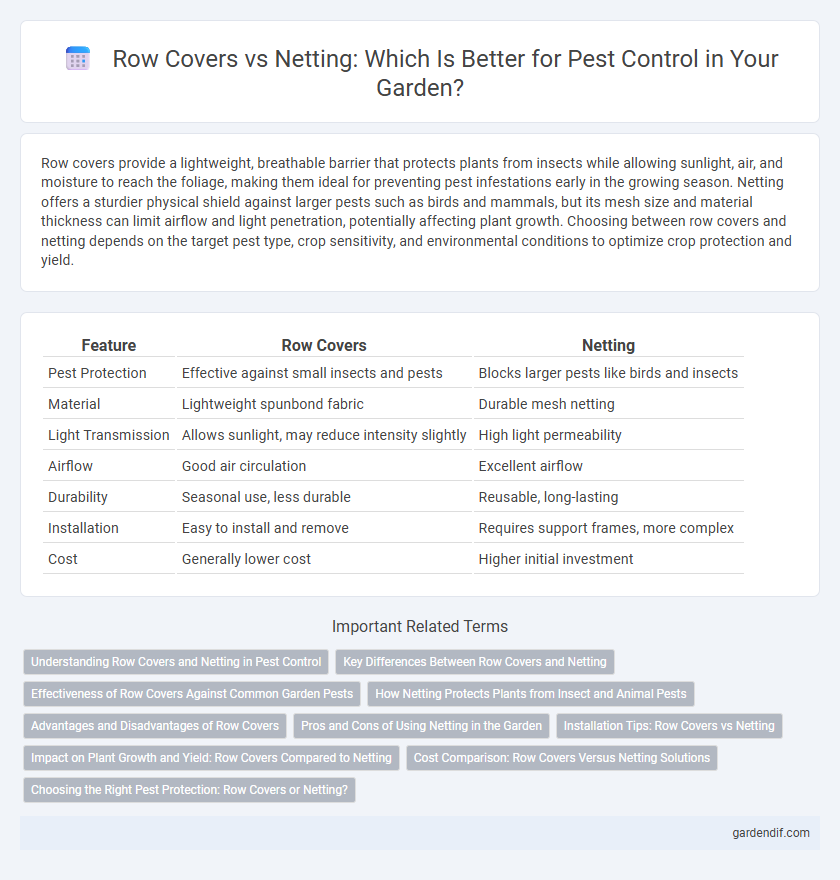
Row covers vs Netting Illustration
Row covers provide a lightweight, breathable barrier that protects plants from insects while allowing sunlight, air, and moisture to reach the foliage, making them ideal for preventing pest infestations early in the growing season. Netting offers a sturdier physical shield against larger pests such as birds and mammals, but its mesh size and material thickness can limit airflow and light penetration, potentially affecting plant growth. Choosing between row covers and netting depends on the target pest type, crop sensitivity, and environmental conditions to optimize crop protection and yield.
Table of Comparison
| Feature | Row Covers | Netting |
|---|---|---|
| Pest Protection | Effective against small insects and pests | Blocks larger pests like birds and insects |
| Material | Lightweight spunbond fabric | Durable mesh netting |
| Light Transmission | Allows sunlight, may reduce intensity slightly | High light permeability |
| Airflow | Good air circulation | Excellent airflow |
| Durability | Seasonal use, less durable | Reusable, long-lasting |
| Installation | Easy to install and remove | Requires support frames, more complex |
| Cost | Generally lower cost | Higher initial investment |
Understanding Row Covers and Netting in Pest Control
Row covers create a physical barrier that protects plants from insects by covering crops with lightweight, breathable fabric, effectively preventing pest access while allowing sunlight and moisture to reach the plants. Netting, made from durable mesh, provides a similar protective shield but is particularly effective at excluding larger pests like birds and moths while facilitating air circulation. Choosing between row covers and netting depends on the specific pest threats and crop requirements, optimizing pest control through targeted exclusion methods.
Key Differences Between Row Covers and Netting
Row covers are lightweight fabric barriers primarily used to protect plants from insects, frost, and wind while allowing sunlight, air, and moisture to reach the crops. Netting consists of mesh materials designed to block larger pests such as birds and larger insects but may provide less frost protection compared to row covers. The key difference lies in their material and purpose: row covers focus on microclimate and insect exclusion with breathable fabric, whereas netting mainly prevents physical access by larger pests without significantly altering temperature or moisture levels.
Effectiveness of Row Covers Against Common Garden Pests
Row covers provide a physical barrier that effectively protects plants from common garden pests like aphids, cabbage worms, and flea beetles by preventing direct contact. These covers also maintain a microclimate that can enhance plant growth while reducing pest damage without the need for chemical pesticides. Compared to netting, row covers offer superior protection against smaller insects that netting mesh often fails to block.
How Netting Protects Plants from Insect and Animal Pests
Netting serves as a physical barrier that prevents insect pests such as aphids, beetles, and caterpillars from reaching plant surfaces, thereby reducing damage and the spread of disease. It also protects crops from larger animal pests like birds, deer, and rabbits, effectively minimizing crop loss and promoting healthy growth. Compared to row covers, netting offers superior airflow and light penetration while maintaining robust pest exclusion capabilities.
Advantages and Disadvantages of Row Covers
Row covers provide excellent protection against a wide range of pests by creating a physical barrier while allowing light, air, and moisture to reach plants, promoting healthy growth. They are lightweight, easy to install, and help extend the growing season by insulating plants from temperature fluctuations but can trap moisture and increase humidity, potentially encouraging fungal diseases. Unlike netting, row covers completely block pests but may require regular monitoring to prevent overheating and are less durable against heavy wind or rain.
Pros and Cons of Using Netting in the Garden
Netting in the garden offers effective protection against larger pests like birds and insects while allowing sunlight, air, and water to penetrate, promoting healthy plant growth. Its durability and reusability make it a cost-effective option, though installation can be labor-intensive and it may not prevent smaller pests from entering. Unlike row covers, netting typically provides less insulation against temperature fluctuations, which can impact plant development in cooler climates.
Installation Tips: Row Covers vs Netting
Row covers require secure anchoring by burying edges in soil to prevent pest entry and wind displacement. Netting demands tensioning on sturdy frames with tight mesh and fixed edges to effectively block larger pests while allowing airflow. Selecting the appropriate installation method enhances pest control efficiency for crops.
Impact on Plant Growth and Yield: Row Covers Compared to Netting
Row covers create a controlled microclimate that increases temperature and humidity, promoting faster plant growth and higher yields by protecting crops from pests and frost. Netting allows greater air circulation and light penetration, which can reduce the risk of disease but may offer less protection against small insects, potentially impacting yield. Studies show row covers often result in a 10-20% yield increase compared to netting due to improved growing conditions and pest exclusion.
Cost Comparison: Row Covers Versus Netting Solutions
Row covers typically offer a lower initial cost compared to netting solutions, making them a budget-friendly option for small-scale pest protection. Netting, while often more expensive upfront, provides greater durability and long-term pest exclusion benefits, reducing replacement frequency. Considering cost per use and crop type, row covers serve well for seasonal applications, whereas netting is cost-effective for prolonged, multi-season pest management.
Choosing the Right Pest Protection: Row Covers or Netting?
Row covers provide effective pest protection by creating a physical barrier that blocks insects while allowing light and moisture to reach plants, ideal for vegetable crops sensitive to pests. Netting offers a versatile solution for larger plants and fruit trees, preventing birds and larger insects from causing damage without restricting airflow. Selecting the right option depends on crop type, pest species targeted, and environmental conditions to optimize pest management and crop health.
Row covers vs Netting Infographic

 gardendif.com
gardendif.com